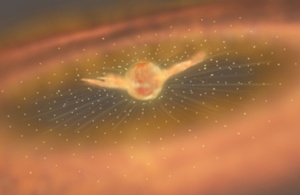Young sun’s violent history solves meteorite mystery
Herschel finds evidence of mighty stellar winds that could solve a puzzling meteorite mystery in our own back yard.

Violent wind gusting around protostar
Astronomers using Europe’s Herschel space observatory to probe the turbulent beginnings of a Sun-like star have found evidence of mighty stellar winds that could solve a puzzling meteorite mystery in our own back yard.
In spite of their tranquil appearance in the night sky, stars are scorching furnaces that spring to life through tumultuous processes – and our 4.5 billion-year-old Sun is no exception. To glimpse its harsh early days, astronomers gather clues not only in the Solar System but also by studying young stars elsewhere in our Galaxy.

Herschel image of stellar nursery OMC2 FIR4
Using Herschel to survey the chemical composition of regions where stars are being born today, a team of astronomers has noticed that one object in particular is different.
The unusual source is a prolific stellar nursery called OMC2 FIR4, a clump of new stars embedded in a gaseous and dusty cloud near to the famous Orion Nebula.
Dr Cecilia Ceccarelli, of the Institute de Planétologie et d’Astrophysique de Grenoblek, said:
To our great surprise, we found that the proportion of two chemical species, one based on carbon and oxygen and the other on nitrogen, is much smaller in this object than in any other protostar we know.
In an extremely cold environment, the measured proportion could arise by one of the two compounds freezing onto dust grains and becoming undetectable. However, at the relatively ‘high’ temperature of about –200°C found in star-forming regions like OMC2 FIR4, this should not occur.
Dr Ceccarelli adds:
The most likely cause in this environment is a violent wind of very energetic particles, released by at least one of the embryonic stars taking shape in this proto-stellar cocoon.
Astronomers think that a similarly violent wind of particles also gusted through the early Solar System, and this discovery might finally point to an explanation for the origin of a particular chemical element seen in meteorites.
These new observations of OMC2 FIR4 also give a very strong hint that our Sun must have blown a violent wind in its youth.
Göran Pilbratt, ESA’s Herschel project scientist, said:
Observing star-forming regions with Herschel not only provides us with a view on what happens beyond our cosmic neighbourhood, but it’s also a crucial way to piece together the past of our own Sun and Solar System.
Herschel and the UK
Herschel is a flagship mission of the UK Space Agency, which funded the UK’s involvement in the UK-led SPIRE instrument. This key component of the satellite was led by a Principal Investigator from Cardiff University. More information about UK involvement in Herschel can be found on our Herschel page.